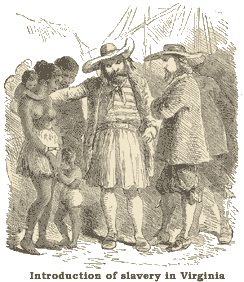Slavery existed on a wide scale in ancient times and was viable around 1450, when it was introduced into the New World by the Portuguese. They were experienced explorers of the West African coast and originally purchased slaves from there to serve as agricultural workers at home.
 Also during the 15th century, various Arab traders began dealing in slaves in North Africa and shipped them to locations throughout the Middle East. The English, Dutch and French soon followed the Portuguese lead after having failed to enslave the Native Americans. African slaves proved to be both cheap to maintain and largely immune to many tropical diseases.
The number of black slaves in America did not immediately expand after the Dutch brought the first boatload to Jamestown in 1619. Slavery as an institution was not formally recognized in Virginia until 1664. Opposition to the slave trade developed early, particularly among Quakers and Mennonites. The Mennonites in Pennsylvania passed a resolution against slavery in 1688, the earliest known anti-slavery protest in the colonies.
It was only after the advent of the plantation system, with its need for dependable laborers capable of performing arduous labor over a long growing season, that the number of slaves grew rapidly. Tobacco, rice and Indigo production became profitable.
Newport, Rhode Island, was one of the busiest ports of the slave trade. The merchants of the small colony, lacking the agricultural advantages of other areas, found it difficult to develop a dependable product for export. However, they found a ready market for rum. Rather than ship their liquor to European ports, they found it more profitable to take the rum directly to West Africa where it was exchanged for slaves. The human cargo, in turn, was taken to the southern colonies and exchanged for sugar and gold.
By 1800, there were about 900,000 slaves in the United States; fewer than 40,000 of them lived in the northern states.
Also during the 15th century, various Arab traders began dealing in slaves in North Africa and shipped them to locations throughout the Middle East. The English, Dutch and French soon followed the Portuguese lead after having failed to enslave the Native Americans. African slaves proved to be both cheap to maintain and largely immune to many tropical diseases.
The number of black slaves in America did not immediately expand after the Dutch brought the first boatload to Jamestown in 1619. Slavery as an institution was not formally recognized in Virginia until 1664. Opposition to the slave trade developed early, particularly among Quakers and Mennonites. The Mennonites in Pennsylvania passed a resolution against slavery in 1688, the earliest known anti-slavery protest in the colonies.
It was only after the advent of the plantation system, with its need for dependable laborers capable of performing arduous labor over a long growing season, that the number of slaves grew rapidly. Tobacco, rice and Indigo production became profitable.
Newport, Rhode Island, was one of the busiest ports of the slave trade. The merchants of the small colony, lacking the agricultural advantages of other areas, found it difficult to develop a dependable product for export. However, they found a ready market for rum. Rather than ship their liquor to European ports, they found it more profitable to take the rum directly to West Africa where it was exchanged for slaves. The human cargo, in turn, was taken to the southern colonies and exchanged for sugar and gold.
By 1800, there were about 900,000 slaves in the United States; fewer than 40,000 of them lived in the northern states.